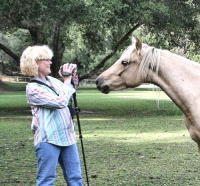 In this wonderful age of technology, you no longer need fancy camera equipment to get that Award-Winning photo of your horse. Â The camera on your smartphone, some time in practicing and a little luck in being camera-in-hand at the right moment will do it. Â Â Start with 100 pics each session and you should have 1 spectacular one. Â As you practice, you will end up with 2 good ones, then 3 and so on.
In this wonderful age of technology, you no longer need fancy camera equipment to get that Award-Winning photo of your horse. Â The camera on your smartphone, some time in practicing and a little luck in being camera-in-hand at the right moment will do it. Â Â Start with 100 pics each session and you should have 1 spectacular one. Â As you practice, you will end up with 2 good ones, then 3 and so on.
Here are some tips that I have learned in my 18+ years of studio work that you can practice with:
1. Consider your composition and place your subject ‘off-center’. It is often said that an artist spends more time planning where they want the viewer’s eye to travel – than actually painting. It’s the same with photography. This careful thought into the composition (where items/subjects rest in the real estate of your picture) determines if the viewer’s eye is going to hang out for awhile and be entertained…or if it’s going to see 1 point of interest and leave.
Placing your subject slightly off-center with enticing paths in the background for the eyes to follow will keep the viewer looking at your image. Try colorful objects, figures, fences, roads, horizons, mountaintops, tree-lines, shorelines, footsteps in the sand, etc.   Then bring the eye back to your main subject. Look at a pic now and pay attention to where your eye ball moves. See what I mean?
2. Â Thanks to the Delete button, we have lots of new creative powers. Â Use the ‘action’ or ‘sports’ multi-shutter setting on your camera. Â Then pick the best one and delete the rest. Â This is wonderful for getting that perfect leg position or the best wind-blown mane. Â Even with still shots, if the horse flinches, you should have a good one before or after the flinch.
3. Â The subject should be at least 75% of the image and the background 25% for head, shoulders or body shots. Â For Scenic shots, the horse should be at least 25% of the image.
4.  The best times to shoot are in the late afternoon when the shadows are long.  Or early in the morning when the light is brightest and warmest in color and the shadows are still long.  Never shoot at high noon.  The 2D camera will have no contrast to work with and your images will be flat.
5. Â Subject in the sun. Â You in the shade. Â This will prevent any light from hitting the lens and causing distortions, blurring and faulty colors.
6. Â Windy days can make dramatic shots. Â The flowing mane and landscaping will bring ‘action’ to still subjects.
7. Â Notice the color of the background. Â White horse/grey barn…not good. Â White horse/green trees..beautiful contrast. Â Sometimes just taking a step or twisting left or right will change your background from crappy to gorgeous!
8.  Ears forward for portrait shots.  Use a treat or a reactionary command if needed.
9.  No posing – you or the horse.  When the brain sees a pic, it knows the body isn’t there, so the emotion is one of voyeurism or being a ‘peeping Tom’.  Making up a story is it’s first reaction, so it knows how to file and prioritize the data the eyes are logging.  If the subjects are posed, then the brain tells the eyes to move on…there is no story here that I can create.
10. Â Don’t over-filter…either pre-shot or post-shot. Â Pre-shot is with your camera settings/apps and Post-shot is with your editing software/apps. Â It’s obvious and unattractive. Â Just take a new shot.
11. Â An intimate subject/moment calls for intimate framing. Â Don’t be afraid to pull the viewer in by zooming in a little bit more. Â On the other hand…
12.  Is it micro-photo art or did you zoom in a bit too much?  There is no expression in the eyeball itself.  If you are fascinated by the mirror images that reflect in your horses eye when you get really close, then you WILL need the special micro lenses and equipment that make that image work.  Close-up portraiture needs the horses natural means of communicating emotion to  create that story for the viewer – i.e., head tilt, eye lids, ear postions, mouth/lip/tongue movements, clear focus and lighting.  And/or an intimate moment with another subject or object – like a wind-blown piece of mane, a leafy branch, a worn and story-filled bridle, etc.
Mute your phone and go create! Â Your horse will love the attention and your brain will love the exercise.
Bj. deCastro


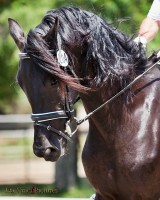 Bits are truly an art form and can be traced throughout the history of mankind and the taming of the horse. The shapes and purposes of the bit reflect the intended use for the horse for the battlefield, farming and transportation.
Bits are truly an art form and can be traced throughout the history of mankind and the taming of the horse. The shapes and purposes of the bit reflect the intended use for the horse for the battlefield, farming and transportation.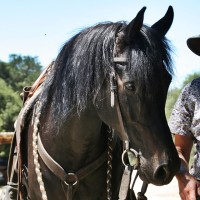 Modern metals have completely transformed bits for horses. Plastics, rubber, German Silver, Aurigan a nickel free alloy, Sweet Iron, copper, just to name a few. I think one of my personal favorites is the Sweet Iron. It is not shiny and is rather dark and dull looking metal but it is not reactive and the horses really like bits made of this metal that is often inlaid with copper. Most of the new metals used today are nonreactive to a horse’s saliva and are quite pleasant to the taste and warm quickly.
Modern metals have completely transformed bits for horses. Plastics, rubber, German Silver, Aurigan a nickel free alloy, Sweet Iron, copper, just to name a few. I think one of my personal favorites is the Sweet Iron. It is not shiny and is rather dark and dull looking metal but it is not reactive and the horses really like bits made of this metal that is often inlaid with copper. Most of the new metals used today are nonreactive to a horse’s saliva and are quite pleasant to the taste and warm quickly.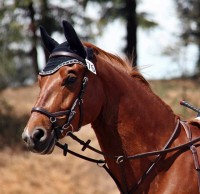 I enjoy learning about all types of bits through the reading and studying of tack catalogs. There are so many choices for each discipline designed to encourage most horses to chew and salivate, leading to a soft mouth and acceptance of the bit.
I enjoy learning about all types of bits through the reading and studying of tack catalogs. There are so many choices for each discipline designed to encourage most horses to chew and salivate, leading to a soft mouth and acceptance of the bit.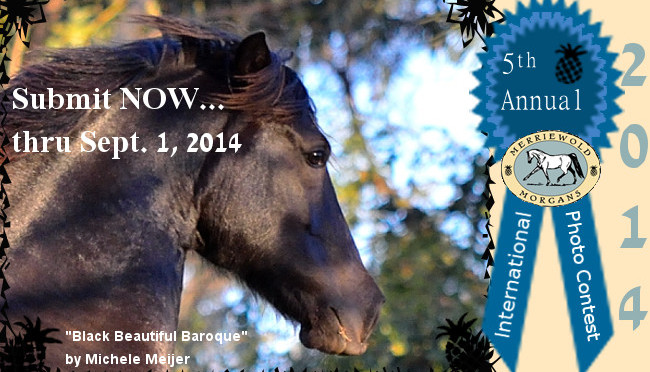
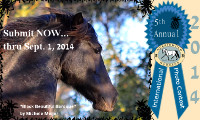 Grab your cameras!  Search through your photos! Join in the fun and win great prizes! Merriewold Morgans is having our 5th Annual Photo Contest celebrating the Magnificent Morgan Horse. Entry is FREE and will be judged by equine photographer, Casey McBride and fine artist and life-long equestian, Entera.
Grab your cameras!  Search through your photos! Join in the fun and win great prizes! Merriewold Morgans is having our 5th Annual Photo Contest celebrating the Magnificent Morgan Horse. Entry is FREE and will be judged by equine photographer, Casey McBride and fine artist and life-long equestian, Entera. All prizes are donated by
All prizes are donated by 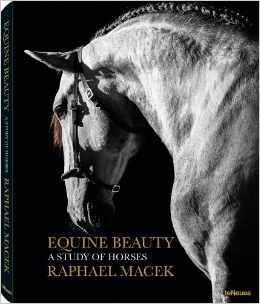 Beautiful, artistic, dramatic and sumptuous are some of the words that come to mind looking at these magnificent images of the Horse.  The legendary and complex relationship between humans and horses is an enduring one.  The horse’s distinctive blend of grace and strength and it’s sleek beauty has long been analyzed, admired and represented in artistic form–whether through painting, sculpture or photography.  Raphael Macek’s inspiring images of equine majesty feature both close-ups and complete figures against the backdrops of artful landscapes.
Beautiful, artistic, dramatic and sumptuous are some of the words that come to mind looking at these magnificent images of the Horse.  The legendary and complex relationship between humans and horses is an enduring one.  The horse’s distinctive blend of grace and strength and it’s sleek beauty has long been analyzed, admired and represented in artistic form–whether through painting, sculpture or photography.  Raphael Macek’s inspiring images of equine majesty feature both close-ups and complete figures against the backdrops of artful landscapes.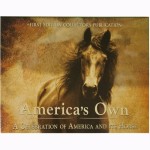 This book pays tribute to America’s first breed of horse, the Morgan, through 50 true stories of the Morgan’s amazing influence on the America we know today.  Through this combination of both famous and lesser-known anecdotes, you’ll experience and discover how the Morgan Horse shaped the development of the East Coast, took the horse racing world by storm, changed the course of history in the Civil War, settled the Western Frontier as the mount of the pioneer, connected the nation through the Pony Express, and so much more.
This book pays tribute to America’s first breed of horse, the Morgan, through 50 true stories of the Morgan’s amazing influence on the America we know today.  Through this combination of both famous and lesser-known anecdotes, you’ll experience and discover how the Morgan Horse shaped the development of the East Coast, took the horse racing world by storm, changed the course of history in the Civil War, settled the Western Frontier as the mount of the pioneer, connected the nation through the Pony Express, and so much more.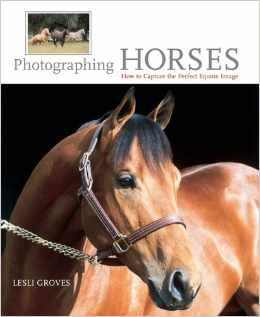 This book is for people with an affinity for horses, regardless of their affinity for cameras.  Logically, they have the greatest appreciation for better horse pictures, even if they don’t have a clue how to take them.
This book is for people with an affinity for horses, regardless of their affinity for cameras.  Logically, they have the greatest appreciation for better horse pictures, even if they don’t have a clue how to take them.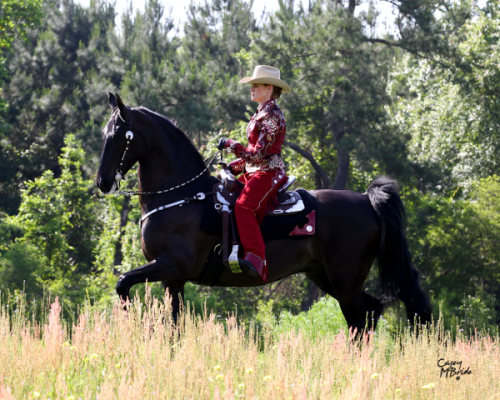 Casey McBride has been photographing horses of all types for the past 27 years. He started working for his grandfather, Jack Schatzberg, at the age of 13 working in the darkroom, getting ears up, win shots, shooting halter horses and traveling the nation.  In his early 20’s he was ready to start on his own and started Casey McBride Photography (
Casey McBride has been photographing horses of all types for the past 27 years. He started working for his grandfather, Jack Schatzberg, at the age of 13 working in the darkroom, getting ears up, win shots, shooting halter horses and traveling the nation.  In his early 20’s he was ready to start on his own and started Casey McBride Photography (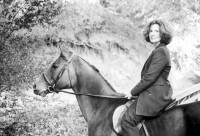

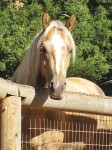 Observation is our best tool for establishing a horse health regimen. I find that basic care practices along with keen observation of the horse can make a huge difference in the condition of your horse and save on veterinary bills and heartache.
Observation is our best tool for establishing a horse health regimen. I find that basic care practices along with keen observation of the horse can make a huge difference in the condition of your horse and save on veterinary bills and heartache.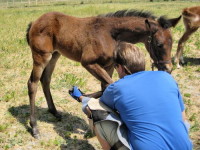 Farrier: A capable farrier is vital to the soundness of your horse. Improper hoof angle and toe length are two items that contribute to injury. Each horse is unique in its conformation and you must have a farrier that shoes or trims according to the individual. I like to keep my horses on a five week schedule mainly to rebalance the angle and keep the toe in check. Frogs and soles should receive minimal work in order to maintain the natural function.
Farrier: A capable farrier is vital to the soundness of your horse. Improper hoof angle and toe length are two items that contribute to injury. Each horse is unique in its conformation and you must have a farrier that shoes or trims according to the individual. I like to keep my horses on a five week schedule mainly to rebalance the angle and keep the toe in check. Frogs and soles should receive minimal work in order to maintain the natural function.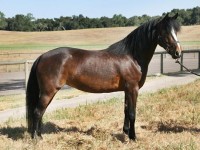 Routine is vital to your horse whether it be care or training. It is very important to feed your horse at scheduled times to prevent colic or digestive issues.      A training routine contributes to fitness and performance.
Routine is vital to your horse whether it be care or training. It is very important to feed your horse at scheduled times to prevent colic or digestive issues.      A training routine contributes to fitness and performance.